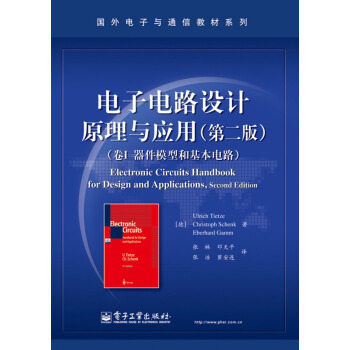![教学经典教材:有限元(第3版) [Finite Elements:Theory,Fast Solvers,and Application in Solid Mechanics]](https://pic.tinynews.org/11004217/rBEIC0_NW0MIAAAAAABrdwO_gBgAAAYvAKJjo8AAGuP021.jpg)

具体描述
内容简介
This definitive introduction to finite element methods has been thoroughly updated for this third edition, which features important new material for both research and application of the finite element method.The discussion of saddle point problems is a lughlight of the book and has been elaborated to include many more nonstandard applications. The chapter on applications in elasticity now contains a complete discussion of locking phenomena.
The numerical solution ofelliptic partial differential equations is an important application of finite elements and the author discusses this subject comprehensively. These equations are treated as variational problems for which the Sobolev spaces are the right framework. Graduate students who do not necessarily have any particular background in differential equations but require an introduction to finite element methods will find this text invaluable. Specifically, the chapter on finite elements in solid mechanics provides a bridge between mathematics and engineering.
内页插图
目录
Preface to the Third English EditionPreface to the First English Edition
Preface to the German Edition
Notation
Chapter Ⅰ Introduction
1. Examples and Classification of PDE's
Examples
Classification of PDE's
Well-posed problems
Problems
2. The Maximum Ptinciple
Examples
Corollaries
Problem
3. Finite Difference Methods
Discretization
Discrete maximum principle
Problem
4. A Convergence Theory for Difference Methods
Consistency
Local and global error
Limits of the con-vergence theory
Ptoblems
Chapter Ⅱ Conforming Finite Elements
1. Sobolev Spaces
Introduction to Sobolev spaces
Friedrichs' inequality
Possible singularities of H1 functions
Compact imbeddings
Problems
2. Variational Formulation of Elliptic Boundary-Value Problems of Second Order
Variational formulation
Reduction to homogeneous bound- ary conditions
Existence of solutions
Inhomogeneous boundary conditions
Problems
3. The Neumann Boundary-Value Problem. A Trace Theorem
Ellipticity in H
Boundary-value problems with natural bound-ary conditions
Neumann boundary conditions
Mixed boundary conditions
Proof of the trace theorem
Practi- cal consequences of the trace theorem
Problems
4. The Ritz-Galerkin Method and Some Finite Elements
Model problem
Problems
5. Some Standard Finite Elements
Requirements on the meshes
Significance of the differentia-bility properties
Triangular elements with complete polyno-mials
Remarks on Cl elements
Bilinear elements
Quadratic rectangular elements
Affine families
Choiceof an element
Problems
6. Approximation Properties
The Bramble-Hilbert lemma
Triangular elements with com-plete polynomials
Bilinear quadrilateral elements
In-verse estimates
Clement's interpolation
Appendix: On the optimality of the estimates
Problems
7. Error Bounds for Elliptic Problems of Second Order
Remarks on regularity
Error bounds in the energy normL2 estimates
A simple Loo estimate
The L2-projector
Problems
8. Computational Considerations
Assembling the stiffness matrix
Static condensation
Complexity of setting up the matrix
Effect on the choice of a grid
Local mesh refinement
Implementation of the Neumann boundary-value problem
Problems
Chapter Ⅲ Nonconforming and Other Methods
1. Abstract Lemmas and a Simple Boundary Approximation Generalizations of Cea's lemma
Duality methods
The Crouzeix-Raviart element
A simple approximation to curved boundaries
Modifications of the duality argument
Problems
2. Isoparametric Elements
Isoparametric triangular elements
Isoparametric quadrilateral elements
Problems
3. Further Tools from Functional Analysis
Negative norms
Adjoint operators
An abstract exis- tence theorem
An abstract convergence theorem
Proof of Theorem 3.4
Problems
4. Saddle Point Problems
Saddle points and minima
The inf-sup condition
Mixed finite element methods
Fortin interpolation
……
Chapter Ⅳ The Conjugate Gradient Method
Chapter Ⅴ Multigrid Methods
Chapter Ⅵ Finite Elements in Solid Mechanics
前言/序言
用户评价
这本《教学经典教材:有限元(第3版)》给我的感觉,就像是走入了一座知识的殿堂,每一个章节都充满了严谨的逻辑和深刻的洞见。作者在介绍“高斯积分”的数值求积方法时,详细阐述了其原理和在有限元分析中的应用,这让我了解到,即使是积分运算,在有限元方法中也有着精妙的数值处理技巧。我特别欣赏作者在讲解“单元刚度矩阵”的计算时,引入的“虚功原理”和“最小势能原理”,这两种方法不仅提供了不同的推导路径,更能加深对有限元方法物理基础的理解。虽然书中的数学公式和推导过程确实需要花费不少时间和精力去消化,但正是这种严谨的数学处理,才使得有限元方法能够成为解决复杂工程问题的强大工具。我感觉,这本书就像是一本“武林秘籍”,它教会了我有限元这门“武功”的基本招式和内功心法,而我需要做的,就是不断地练习和领悟,将其运用到实战中去。
评分读完这本《教学经典教材:有限元(第3版)》,我最大的感受是,它并非一本“速成”的指南,而是一部需要细细品味的“工具书”。作者在介绍单元的组装过程时,详细阐述了“滞后求和”和“直接求和”等不同方法的优缺点,以及它们在实际计算中的效率差异。这让我了解到,即使是看似简单的矩阵叠加,其中也蕴含着丰富的优化技巧。我特别花时间研究了书中关于“边界条件处理”的章节,从强制位移边界条件到力边界条件的施加,作者都给出了详细的数学推导和数值实现方法。理解这些细节,对于确保有限元模型的准确性至关重要。虽然我还没有完全掌握书中所有高级的应用技巧,但这本书为我打开了一个新的视角,让我看到了有限元方法在工程领域广阔的应用前景。我甚至开始思考,如何将书中的一些理论知识,应用到我正在进行的某个工程项目中,去解决一些实际遇到的难题。
评分这次的《教学经典教材:有限元(第3版)》体验,给我最深刻的印象莫过于其在“固体力学应用”方面的详尽阐述。我一直以来都对有限元在结构分析、材料力学等领域的应用非常感兴趣,而这本书恰恰满足了这一点。作者并没有将有限元理论仅仅停留在抽象的数学层面,而是将其与实际的工程问题紧密结合。书中大量的实例分析,从简单的梁的弯曲到复杂的应力集中问题,都提供了详实的模型建立、边界条件施加以及结果解释的步骤。我特别是被书中关于非线性问题的处理方式所吸引,例如材料非线性和几何非线性的分析,这在实际工程设计中是不可或缺的。作者通过对这些复杂情况的数学建模和数值求解方法的介绍,让我看到了有限元方法在解决现实世界工程挑战时的强大生命力。虽然书中的某些应用场景对于我这个初学者来说,理解起来还有一定的难度,但其清晰的脉络和一步步的引导,让我感觉自己仿佛置身于一个虚拟的实验室,亲手操作着求解复杂的力学问题。我甚至开始尝试将书中的一些方法应用到我自己的课题研究中,虽然过程磕磕绊绊,但收获颇丰。
评分这本书的排版和内容组织,给人的感觉就是“专业”二字。在讲解“应力与应变”的关系时,作者非常详细地介绍了本构关系的概念,以及不同材料模型(如线弹性、弹塑性)在有限元分析中的体现。我尤其被书中关于“应力奇异性”的分析所吸引,这让我了解到在某些几何条件下,有限元方法的解可能会出现奇异点,以及如何通过网格细化等方法来改善这种情况。作者在介绍有限元方法的求解流程时,将整个过程分解得非常清晰,从预处理、网格划分、边界条件施加,到求解器选择和后处理,每一步都进行了详细的说明。虽然我还没有完全理解所有细节,但这本书为我构建了一个清晰的有限元分析框架,让我知道如何系统地进行一项有限元计算任务。我感觉,这本书就像是一份详细的“操作手册”,它告诉我如何一步步地完成有限元分析,让我能够更自信地去面对实际工程问题。
评分这本《教学经典教材:有限元(第3版)》真的让我又爱又恨,说实话,从第一页翻到最后一页,我感觉自己像是经历了一场数字风暴,各种方程、矩阵、离散化方法在我脑海里不断轰炸,每一次对解法的理解都像是闯过了一个又一个难关。作者在理论部分的讲解可谓是淋漓尽致,从基础的泊松方程到更复杂的应力分析,每一步都拆解得非常细致,让人仿佛能看到力学问题是如何被一步步转化为数学语言,再由有限元这个强大的工具来求解的。尤其是在介绍插值函数和形函数的部分,作者用图文并茂的方式,将抽象的概念具象化,让我这个初学者也能窥见一斑。当然,理论的深度也意味着理解的门槛不低,我常常需要反复阅读,对照着书中的例子,在草稿纸上演算,才能勉强跟上作者的思路。有时候,看着那些复杂的数学推导,真的会产生一种“我是谁,我在哪,我为什么在这里”的迷茫感,但每当攻克一个难点,看到最终的公式推导出来,那种成就感又是无与伦比的。这本书的叙事风格非常严谨,几乎没有丝毫的“闲聊”,每一句话、每一个公式都直指核心,对于想要深入理解有限元理论精髓的读者来说,这无疑是一本宝藏,但也意味着它绝非轻松愉快的读物,需要付出大量的精力和时间去消化。
评分这本书的内容,怎么说呢,就像是一部厚重的百科全书,每个章节都像是一个独立的研究领域,需要你沉下心来,一点一点地去啃。我最开始被吸引的是它强大的理论基础部分,作者在介绍位移法的基本概念时,简直是将整个框架都给拆解开了,从单元的选取、插值函数的构建,到刚度矩阵的组装和求解方程的展开,每一步都环环相扣,逻辑严谨到无可挑剔。我反复阅读了关于单元性质的介绍,比如形状函数是如何决定单元的精度和适用范围的,以及不同类型的单元(如三角形、四边形、六面体等)各自的优缺点。作者的讲解方式非常注重数学的严谨性,对于每一个公式的推导都力求详尽,这让我能够深入理解其背后的物理意义。但不得不说,这确实是一本“硬核”教材,对于数学功底一般的读者来说,可能会觉得有些吃力。我经常需要花费大量的时间去消化那些复杂的矩阵运算和向量代数,有时候甚至需要借助其他参考书来辅助理解。但总的来说,这本书为我打下了坚实的有限元理论基础,让我能够自信地去应对后续更复杂的学习和应用。
评分这本《教学经典教材:有限元(第3版)》给我的感觉,就像是参加了一场严谨的学术研讨会,每一个章节都充满了深度和专业性。作者在描述有限元方法的离散化过程时,简直是将整个过程庖丁解牛一般,从连续域的微分方程出发,如何一步步将其转化为离散化的代数方程组,整个链条清晰可见。我尤其关注了书中关于“网格划分”的策略,包括不同网格密度的选择对计算结果精度的影响,以及如何处理不规则几何形状的网格生成。作者在这方面给出了不少实用的指导,让我意识到网格质量在有限元分析中的重要性。虽然这本书的理论部分非常扎实,但我在阅读过程中,也感受到作者在努力平衡理论与实践之间的关系。书中穿插的一些小型算例,虽然篇幅不长,但却能有效地帮助读者巩固所学的理论知识,并初步体验有限元方法的求解过程。当然,对于那些期望快速上手、直接套用公式的读者来说,这本书可能显得有些“不近人情”。它更适合那些想要深入探究有限元方法背后原理,并希望能够举一反三的读者。
评分这本书的文字量和深度,确实需要投入大量的时间和精力去阅读和理解。作者在描述“能量原理”在有限元方法中的应用时,详细阐述了虚功原理、最小势能原理等,并解释了它们如何指导单元刚度矩阵的构建。我尤其关注了书中关于“模型修正”和“不确定性分析”的讨论,这让我了解到,有限元方法在解决实际问题时,还需要考虑模型的不确定性和误差的传播。虽然书中涉及的某些高级主题,例如“多尺度分析”或者“损伤力学”,我目前还只是初步接触,但这本书为我打开了一个更广阔的视野,让我看到了有限元方法在更前沿领域的应用潜力。我感觉,这本书就像是一本“百科全书”,它涵盖了有限元方法在力学领域的方方面面,而我需要做的,就是不断地去探索和学习,从中汲取知识,并将其应用到我感兴趣的领域。
评分这本书的文字风格非常“理工科”,严谨、精确、不拖泥带水。在讲解“质量矩阵”和“阻尼矩阵”的推导时,作者几乎是逐字逐句地进行分析,并明确了它们在结构动力学分析中的作用。我发现,作者在引入每一个新的概念时,都会先给出其数学定义,然后进行详细的推导,最后再结合物理意义进行解释,这种层层递进的讲解方式,让我能够更深入地理解问题的本质。在“快速求解器”的部分,书中对一些先进的求解算法进行了介绍,比如预条件共轭梯度法,这让我对如何提高大规模有限元问题的求解效率有了更深刻的认识。虽然我目前还无法完全掌握这些高级算法的理论细节,但这本书为我指明了进一步深入学习的方向。我感觉,这本书就像是一本精密的“骨架”,支撑着整个有限元理论体系,而我需要做的,就是在这个骨架上,不断地填充血肉,将其应用到实际的工程问题中去。
评分坦白说,当我拿到这本《教学经典教材:有限元(第3版)》时,我并没有立刻被其厚重的体量所震慑,反而更多的是对“经典”二字的好奇。翻开后,我发现这种“经典”更多地体现在其内容的扎实和理论的系统性上。作者在构建知识体系时,逻辑链条非常清晰,从基本原理出发,逐步引入到各种复杂问题的求解,仿佛在搭建一座知识的殿楼,每一层都坚实可靠。特别是在“快速求解器”这一章节,我看到了作者对于数值计算效率的极致追求。面对大规模的有限元模型,如何快速准确地获得结果,这无疑是实际应用中的关键。书中介绍的几种迭代求解方法,如共轭梯度法等,都进行了深入的剖析,并给出了一些优化技巧,这对于我在工程实践中优化计算效率非常有启发。我尤其欣赏作者在理论讲解过程中,并没有回避那些复杂的数学细节,而是选择将其一一呈现,并辅以清晰的解释。虽然有时候这些推导过程确实需要花费不少时间去理解,但正是这种不回避复杂性的态度,才使得这本书的理论深度和广度都达到了一个相当的高度,让我能够从根本上理解有限元方法的由来和精髓,而不是仅仅停留在“调包侠”的层面。
评分还没看,不错吧!
评分物体离散化后,假定力是通过节点从一个单元传递到另一个单元。但是,对于实际的连续体,力是从单元的公共边传递到另一个单元中去的。因而,这种作用在单元边界上的表面力、体积力和集中力都需要等效的移到节点上去,也就是用等效的节点力来代替所有作用在单元上的力。
评分Goooooooooooooooooooooooooooood
评分当采用位移法时,物体或结构物离散化之后,就可把单元总的一些物理量如位移,应变和应力等由节点位移来表示。这时可以对单元中位移的分布采用一些能逼近原函数的近似函数予以描述。通常,有限元法我们就将位移表示为坐标变量的简单函数。这种函数称为位移模式或位移函数。
评分有限元法(FEA,Finite Element Analysis)的基本概念是用较简单的问题代替复有限元分析(FEA,Finite Element Analysis)利用数学近似的方法对真实物理系统(几何和载荷工况)进行模拟。还利用简单而又相互作用的元素,即单元,就可以用有限数量的未知量去逼近无限未知量的真实系统。杂问题后再求解。它将求解域看成是由许多称为有限元的小的互连子域组成,对每一单元假定一个合适的(较简单的)近似解,然后推导求解这个域总的满足条件(如结构的平衡条件),从而得到问题的解。这个解不是准确解,而是近似解,因为实际问题被较简单的问题所代替。由于大多数实际问题难以得到准确解,而有限元不仅计算精度高,而且能适应各种复杂形状,因而成为行之有效的工程分析手段。选择位移模式
评分This definitive introduction to finite element methods has been thoroughly updated for this third edition, which features important new material for both research and application of the finite element method.
评分根据单元的材料性质、形状、尺寸、节点数目、位置及其含义等,找出单元节点力和节点位移的关系式,这是单元分析中的关键一步。此时需要应用弹性力学中的几何方程和物理方程来建立力和位移的方程式,从而导出单元刚度矩阵,这是有限元法的基本步骤之一。
评分在有限单元法中,选择节点位移作为基本未知量时称为位移法;选择节点力作为基本未知量时称为力法;取一部分节点力和一部分节点位移作为基本未知量时称为混合法。位移法易于实现计算自动化,所以,在有限单元法中位移法应用范围最广。
评分书很好,全新正版。快递更是飞一般的快,特别是书的内容很好,我是看了内容介绍觉得非常好结合最新的流行资讯进行选题策划和执行。同时自己也会站在读者的角度审视自己的选题策划是否具有可读性和时效性。点评该求职者清晰地表达了自己以顾客需求为导向(以读者想了解什么为标准)的原则,向面试官展现了自己敏锐的市场眼光和服务意识。该求职者正确地认识自己的产品(服务)定位和目标客户群,能针对目标客户群采用问卷、访问等方法了解不断变化的需求。尤其在回答中体现了站在顾客角度考虑问题的意识,易博得面试官的好感。案例(2)面试官很多咨询顾问对于一个客户给出的问题解决方案都会很类似,你认为你区别于其他咨询顾问的特点是什么求职者我认为我同其他咨询顾问的最大区别是我能够尽可能地站在客户的角度,考虑客户对解决方案的吸收理解程度和这个方案的可行性。面试官能否具体谈谈你是如何为客户考虑的求职者在进行咨询项目时,提供给客户的解决方案可能只是一个结果,客户往往不能理解我们如何得出这样的解决方案。我会为客户解释我们的信息来源、评价标准以及为什么执行这样的方案是能够得到最佳效果的,让客户充分了解我们为他提供的是最理想的解决方案。同时我们也会让他们的员工了解解决方案产生的过程,并在培训时指导他们解决这类问题的技能,使得他们在以后遇到相同问题时可以迅速独立地解决。面试官能否举一个具体的例子求职者例如,在××公司绩效考评方案改进项目中,我们首先为该公司员工进行绩效考评概念与原则的培训,让该公司相关管理人员充分了解绩效管理的方法。最新修订版!增加了关于员工能力素质要求、面试类型、面试流程、面试官提问方式及面试最难问题的精彩解答。揭示了世界500强选人、用人的标准和操作方法,包括500强最常用的20个员工能力素质要求的具体行为描述。收集了宝洁、汇丰银行、联合利华、英特尔、普华永道等各行业世界知名企业在中国近几年的面试实录。世界500强通用选人标准与在华实践的真实记录不错过书的三大理由为人力资源工作者提供了可资参考借鉴的选拔人才的标准,并对具体选才标准做了详细的行为分析。让求职者了解企业对员工的能力素质要求,帮助求职者掌握应聘技巧和方法,并提供大量素材以供求职者学习和借鉴。世界500强面试实录(第2版)所提供的20种员工能力素质要求的具体行为描述是企业对员工行为规范的一种概括总结,可以作为员工培训发展的标准行为准则。世界500强面试实录(第2版)最适合三种人阅读人力资源工作者的实用工作手册求职者的最佳指导工具员工培训发展的标准行为准则世界500强企业经过多年的发展,积累了大量有关人力资源开发的理论基础及实务经验,因此他们的
相关图书
本站所有内容均为互联网搜索引擎提供的公开搜索信息,本站不存储任何数据与内容,任何内容与数据均与本站无关,如有需要请联系相关搜索引擎包括但不限于百度,google,bing,sogou 等
© 2025 book.idnshop.cc All Rights Reserved. 静思书屋 版权所有


![·中译翻译教材·翻译专业研究生系列教材:应用翻译功能论(第2版) [On Pragmatic Translation with Functionalist Approach (Second Edition)] pdf epub mobi 电子书 下载](https://pic.tinynews.org/11064877/rBEHZ1A0fB8IAAAAAACap4OmZ3UAAAGGgHJOnsAAJq_130.jpg)

![普通高等教育“十一五”国家级规划教材:对外汉语教学实用语法(修订本)练习参考答案及要解 [Teaching Foreigners Practical Chinese Grammar Answers and Notes] pdf epub mobi 电子书 下载](https://pic.tinynews.org/11090077/rBEHalBlCisIAAAAAAC4vYguu0gAABjUgBm5NoAALjV400.jpg)

![高等学校现代统计学系列教材:属性数据分析 [Analysis of Categorical Data] pdf epub mobi 电子书 下载](https://pic.tinynews.org/11284514/5652a6b6N6d7a4473.jpg)

![竞赛数学教程(第3版)/高等学校教材 [A Course in Competitive Mathematics] pdf epub mobi 电子书 下载](https://pic.tinynews.org/11323220/5652a6b7Nc9741694.jpg)








![先进机器人控制/中国科学院研究生院教材 [Advanced Robot Control] pdf epub mobi 电子书 下载](https://pic.tinynews.org/11437102/57464966Ndbdb46a4.jpg)


